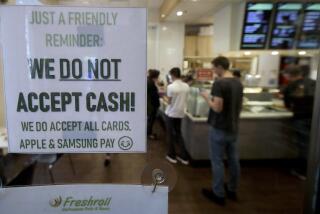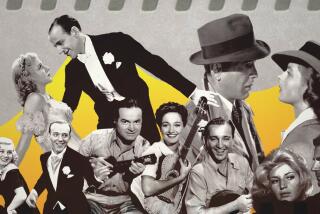Column: Video-on-demand TV circa 1953? Just deposit coins in the slot
- Share via
State-of-the-art TV services such as video on demand or pay per view? No biggie. We’re all accustomed to seeing what we want, when we want, with the click of a remote-control button.
I’ll bet you didn’t know, however, that American TV viewers got their first taste of such technology more than six decades ago with set-top boxes that required you to drop coins into a slot to access premium content.
Call it the “Jurassic Park” of a la carte television.
I wouldn’t have known of this now-largely-forgotten stab at pay-TV were it not for a tattered copy of Reader’s Digest from November 1958. A reader sent it to me the other day with a note saying: “Thought you might be amused by this. Page 57.”
There I found an article titled, “Why Can’t We Have Pay TV?”, which expressed frustration with the quality of free-TV programming — “Gunsmoke” was the top-rated show at the time — and a desire for entertainment that was uninterrupted by commercial breaks.
A footnote mentioned that “several companies have developed metering schemes which will allow you to pay for special programs. All can be attached to your set once Pay TV is legalized.”
As early as the 1950s, it turned out, steps were being taken to introduce rudimentary video on demand to American homes, motivated by a desire to empower consumers who already were fed up with the dreck being foisted on them by TV stations.
Moreover, one of the most prominent pay-TV experiments was conducted right here in Southern California — before it was killed off by advertiser-supported networks and movie theaters that fought tooth and nail to keep pay-TV from finding a wider audience.
“Unfortunately, this experiment just didn’t last long enough for it to take hold,” said Robert Thompson, director of the Bleier Center for Television and Popular Culture at Syracuse University. “The idea was ahead of its time.”
Unlike contemporary pay-TV offerings such as HBO and Netflix, he said, early efforts lacked content that was head and shoulders above what was available on free TV. This limited demand for the ‘50s-era services.
“Also, it was a really clunky system,” he said. “Literally, the coins went clunk when you put them in.”
The service was called Telemeter and it made its debut in Palm Springs on Nov. 27, 1953. Backed by the Paramount movie studio, Telemeter’s cable cost anywhere from $150 to $450 to install, depending on a home’s location, and the coin-operated signal descrambler cost an additional $21.75.
Like a modern cable box, the Telemeter box provided access to free, commercial-festooned programming. But its big advance was to allow users to drop in nickels, dimes and quarters for a la carte programming.
For example, Palm Springs residents were able to pony up four quarters to watch a USC-Notre Dame football game. For $1.35, they could see the first-run movie “Forever Female” starring Ginger Rogers and William Holden.
The average Telemeter household spent around $10 a month on a la carte programming — about $90 in today’s dollars.
From a consumer perspective, this was very cool. A market had been demonstrated for high-quality, commercial-free TV.
The powers that be in the entertainment industry, however, were none too pleased.
Other studios refused to play ball with Paramount and provide access to their movies. Theater owners and TV networks threatened to sue and demanded a regulatory crackdown from the Federal Communications Commission.
By the summer of 1954, only about half a year after being introduced, the plug was pulled on Telemeter. A second stab at offering the pay-TV technology to consumers was made five years later in Canada, but it lost money and was discontinued in 1965.
Another early pay-TV experiment was called Phonevision. Zenith began testing the pay-per-view service in 1951, with customers calling in and ordering movies for $1 each. Phonevision came and went in various cities before finally disappearing in 1969.
“There were a number of experiments that hardly anyone today remembers,” said Steve McVoy, founder of the Early Television Museum in Hilliard, Ohio. “The technology just wasn’t ready.”
Yet even in the age of Howdy Doody, TV viewers already were clamoring for a better TV experience. Commercial breaks on radio had proved to be an annoyance, and were arguably even more obnoxious with the addition of moving pictures.
“It’s intriguing to think what could have happened if pay-TV had taken hold this far back,” said Walter Podrazik, television curator for the Museum of Broadcast Communications in Chicago. “There was always more out there than what was available on the networks.”
He said pay-per-view access in the 1950s and ’60s to such things as sports, movies, theater and concerts would have reshaped the landscape of American popular culture. People quickly would have grown accustomed to the idea that they didn’t have to settle for the likes of “Gilligan’s Island” or “The Beverly Hillbillies.”
It’s not unreasonable, Podrazik said, to think that a widely adopted Telemeter or Phonevision system could have ushered in a wave of more sophisticated TV, just as HBO’s “The Sopranos” influenced both free- and pay-TV content after debuting in 1999.
“It was an alternative that never really got an airing on any major scale,” he said. “Instead, we were stuck with free TV and a lot of commercials.”
Pay-TV didn’t really take off until the 1980s, when federal regulators gave the industry more elbow room and cable companies learned to bundle channels into fat, take-it-or-leave-it packages, offering customers a staggering array of choices at ever-increasing prices.
We’re now seeing a rerun of earlier battles as the pay-TV industry seeks to prevent introduction of a la carte services that would allow consumers to pay only for the channels they want, rather than the hundreds they may never watch.
“We’re going to some form of a la carte whether the pay-TV providers like it or not,” Podrazik predicted. “It’s what people desire.”
That Reader’s Digest article noted that even in 1958, 93% of TV viewers surveyed said they’d be willing to pay for better programming, just as a 2015 poll found that 82% of consumers would prefer a la carte channel choices.
“Congress,” the article concluded, “how about clearing the track for that experiment?”
Yeah, Congress, how about it?
David Lazarus’ column runs Tuesdays and Fridays. He also can be seen daily on KTLA-TV Channel 5 and followed on Twitter @Davidlaz. Send your tips or feedback to david.lazarus@latimes.com.
ALSO
When companies get hacked, they take their privacy a lot more seriously than yours
Does your credit card make you feel more attractive? Wells Fargo wants to know
More to Read
The biggest entertainment stories
Get our big stories about Hollywood, film, television, music, arts, culture and more right in your inbox as soon as they publish.
You may occasionally receive promotional content from the Los Angeles Times.











